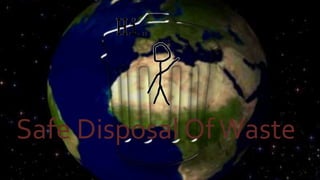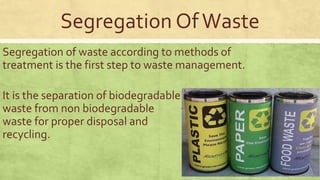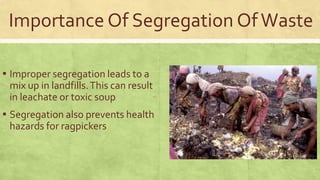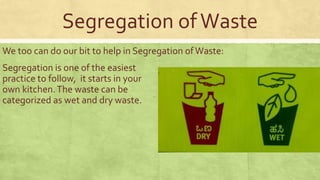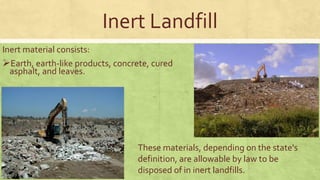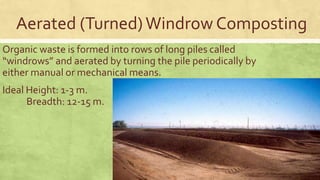Safe Disposal of Waste
- 1. Safe Disposal Of Waste
- 2. Waste What Is Waste Waste and wastes are terms for unwanted materials like - • Municipal solid waste • Hazardous waste • Waste water • Radioactive waste • Biological waste
- 3. Disposal Of Waste There are various methods for disposal of waste like: 1) Segregation Of Waste 2) Landfill / Dumping Of Waste 3) Composting Of Waste 4) Drainage
- 4. Segregation Of Waste Segregation of waste according to methods of treatment is the first step to waste management. It is the separation of biodegradable waste from non biodegradable waste for proper disposal and recycling.
- 5. Segregation Of Waste A classic example of suitable containers for the segregation of waste streams are the blue, yellow, green and red recycling bins. Each colour used to collect one type of waste • Red are for metal cans • Blue for paper and cardboard • Green or Yellow for plastic
- 7. Importance Of Segregation Of Waste ‚ñ™ Improper segregation leads to a mix up in landfills. This can result in leachate or toxic soup ‚ñ™ Segregation also prevents health hazards for ragpickers
- 8. Importance Of Segregation Of Waste ‚ñ™ When the waste is not separated properly it leads to less recycling because it is not easy to remove materials for recycling.
- 9. Segregation of Waste We too can do our bit to help in Segregation of Waste: Segregation is one of the easiest practice to follow, it starts in your own kitchen. The waste can be categorized as wet and dry waste.
- 11. Landfills A landfill site (also known as a tip, dump, rubbish dump or dumping ground ) is a site for • Disposal of waste materials by burial • Oldest form of waste treatment.
- 12. Landfill Gas Landfill gas is a complex mix of different gases created by the action of microorganisms within a landfill.
- 13. Importance of Landfills ‚ñ™ Helps reduce area occupied by waste. ‚ñ™ Serve to prevent contamination between the waste and the surrounding environment, especially groundwater. ‚ñ™ Waste Management uses landfill gas as an energy source.
- 14. Parts Of A Landfill ‚ñ™ Bottom liner ‚ñ™ Cells (old and new) ‚ñ™ Leachate collection system ‚ñ™ Storm water drainage ‚ñ™ Methane collection system ‚ñ™ Cover (or cap) ‚ñ™ Groundwater monitoring stations
- 16. Types Of Landfills There are 3 Main types of Landfills: 1)Municipal Solid Waste (MSW) Landfill 2)Construction and Demolition Landfill 3)Inert Landfill
- 17. Municipal Solid Waste Landfill Highly engineered, state permitted disposal facility where ÔÇß municipal solid waste (non-hazardous waste residences, hotels, including commercial and industrial waste) disposed ÔÇß Long-term care and monitoring of waste undertaken.
- 18. Construction & Demolition landfill Construction and demolition (C&D) debris: ‚ñ™ produced in construction, renovation and/or demolition of structures ‚ñ™ typically includes concrete, asphalt, wood, gypsum wallboard, paper, glass, rubble, and roofing materials. ‚ñ™ Land clearing debris, such as stumps, rocks and dirt
- 19. Inert Landfill Inert material consists: ÔÉòEarth, earth-like products, concrete, cured asphalt, and leaves. These materials, depending on the state's definition, are allowable by law to be disposed of in inert landfills.
- 20. Composting
- 21. Composting Composting: biological decomposition of organic waste • food or plant material by bacteria, fungi, worms and other organisms • under controlled aerobic (occurring in the presence of oxygen) conditions.
- 23. Types of composting Types of Composting: ‚ñ™ Vermicomposting ‚ñ™ Aerated (Turned) Windrow Composting ‚ñ™ In-Vessel Composting
- 24. Vermicomposting Red worms or field worms found in gardens- are placed in bins with organic matter in order to break it down into a high-value compost called castings. Worm bins are easy to construct (they are also commercially available)
- 25. Vermicomposting Types of Waste: Worms will eat almost anything in a typical compost pile (e.g., food scraps, paper, plants). Climate or Seasonal Considerations: The optimal temperatures - 55° F to 77° F. Requirements: worms, worm bedding and a bin to contain the worms and organic matter.
- 26. Vermicomposting
- 27. Aerated (Turned) Windrow Composting Organic waste is formed into rows of long piles called “windrows” and aerated by turning the pile periodically by either manual or mechanical means. Ideal Height: 1-3 m. Breadth: 12-15 m.
- 28. Aerated (Turned) Windrow Composting Types of Waste: Yard trimmings, grease, liquids, and animal byproducts (such as fish and poultry wastes) Climate or Seasonal Considerations: Warm, arid climate. Cold temperatures. Environmental Concerns: Leachate is liquid released during the composting process. This can contaminate local ground-water and surface-water supplies Requirements: Large tracts of land, sturdy equipment, a continual supply of labor to maintain and operate the facility.
- 29. In-Vessel Composting Organic materials are fed into a drum, silo, concrete-lined trench, or similar equipment where the environmental conditions-including temperature, moisture, and aeration-are closely controlled.
- 30. In-Vessel Composting Types of Waste: Basic organic wastes like meat, animal manure, biosolids, food scraps Climate or Seasonal Considerations: any climate because the environment is carefully controlled Requirements: Huge capital and a technical assistance to operate properly
- 31. Drainage
- 32. Drainage • Drainage is the system of water or waste liquids flowing away from somewhere into the ground or down pipes. • Drainage is done in combination with rainwater harvesting
- 33. Advantages Of Drainage System Advantages: • Remove excess water and remove water logging. • Remove the stench of wastewater collection. • Prevent: soil erosion and spread of disease –causing bacteria. • Maintain a clean and healthy environment.
- 34. Drain-Waste-Vent a Drain-waste-vent (or DWV) is part of a system that removes sewage and greywater from a building and regulates air pressure in the waste-system pipes, facilitating flow. Waste is produced at fixtures such as toilets, sinks and showers, and exits the fixtures through a trap, a dipped section of pipe that always contains water.
- 35. Made By: Akash Dubey Hursh Naik Ishaan Sood Raghavendra Pathria Yohann Mathew
